Sling (weapon): Difference between revisions
No edit summary |
|||
| Line 5: | Line 5: | ||
A '''sling''' is a projectile [[weapon]] typically used to throw a blunt [[projectile]] such as a stone or lead bullet. It is also known as the '''shepherd's sling'''. |
A '''sling''' is a projectile [[weapon]] typically used to throw a blunt [[projectile]] such as a stone or lead bullet. It is also known as the '''shepherd's sling'''. |
||
A sling has a small cradle or ''pouch'' in the middle of two lengths of cord. The ''sling stone'' is placed in the pouch. |
A sling has a small cradle or ''pouch'' in the middle of two lengths of cord. The ''sling stone'' is placed in the pouch. The index finger is placed through the loop, the other string has a tab that is placed between the thumb and forefinger. The sling is swung and with a flick of the wrist the tab is released at the precise moment. This frees the projectile to fly to the tangent.The sling derives its effectiveness by essentially extending the length of a human arm, thus allowing stones to be thrown several times farther than they could be by hand. |
||
The sling is very inexpensive and easy to build. It has historically been used for hunting [[Game (food)|game]] and in combat. Today it still interests sportsmen as a survival tool and as an improvised weapon. It is also possible to see the sling used in riots around the world. |
The sling is very inexpensive and easy to build. It has historically been used for hunting [[Game (food)|game]] and in combat. Today it still interests sportsmen as a survival tool and as an improvised weapon. It is also possible to see the sling used in riots around the world. |
||
Revision as of 03:54, 21 August 2011
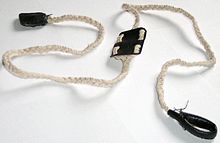
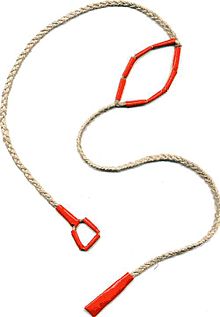
A sling is a projectile weapon typically used to throw a blunt projectile such as a stone or lead bullet. It is also known as the shepherd's sling.
A sling has a small cradle or pouch in the middle of two lengths of cord. The sling stone is placed in the pouch. The index finger is placed through the loop, the other string has a tab that is placed between the thumb and forefinger. The sling is swung and with a flick of the wrist the tab is released at the precise moment. This frees the projectile to fly to the tangent.The sling derives its effectiveness by essentially extending the length of a human arm, thus allowing stones to be thrown several times farther than they could be by hand.
The sling is very inexpensive and easy to build. It has historically been used for hunting game and in combat. Today it still interests sportsmen as a survival tool and as an improvised weapon. It is also possible to see the sling used in riots around the world.
The sling in antiquity
Origins
The sling is an ancient weapon. It is certain that slings were known to Neolithic peoples around the Mediterranean, but it seems likely that the sling is much older. It is quite possible that the sling was invented during the Upper Paleolithic at a time when new technologies, such as the atlatl and the bow and arrow, were emerging. With the exception of Australia, where spear throwing technology such as the woomera predominated, the sling became common all over the world, although it is not clear whether this occurred because of cultural diffusion or independent invention.
Archaeology
Whereas sling-bullets are common finds in the archaeological record, slings themselves are rare. This is because a sling's materials are biodegradable and because slings are low-status weapons, rarely preserved in a wealthy person’s grave.
The oldest known extant slings were found in the tomb of Tutankhamen who died about 1325 BC. A pair of finely plaited slings were found with other weapons. The sling was probably intended for the departed pharaoh to use for hunting game.[1]
Another Egyptian sling was excavated in El-Lahun in Al Fayyum Egypt in 1914 by William Matthew Flinders Petrie. It now resides in the Petrie Museum of Egyptian Archaeology. It was found alongside an iron spearhead. Petrie dated it to about 800 BC. The remains are broken into three sections. Although fragile, the construction is clear: it is made of bast fibre (almost certainly flax) twine; the cords are braided in a 10-strand elliptical sennit and the cradle seems to have been woven from the same lengths of twine used to form the cords.[2]

Ancient representations
Representations of slingers can be found on artifacts from all over the ancient world, including Assyrian and Egyptian reliefs, the columns of Trajan[3] and Marcus Aurelius, on coins and on the Bayeux Tapestry.
Written history
The sling is mentioned by Homer[4] and by many other Greek authors. The historian of the famous retreat of the Ten Thousand, 401 BC, relates that the Greeks suffered severely from the slingers in the army of Artaxerxes II of Persia, while they themselves had neither cavalry nor slingers, and were unable to reach the enemy with their arrows and javelins. This deficiency was later rectified when a company of 200 Rhodians, who understood the use of leaden sling-bullets, was formed. They were able, says Xenophon, to project their missiles twice as far as the Persian slingers, who used large stones.[5]
Ancient authors seemed to believe, incorrectly, that sling-bullets could penetrate armour, and that lead projectiles, heated by their passage through the air, would melt in flight.[6][7] In the first instance, it seems likely that the authors were indicating that slings could cause injury through armour by a percussive effect rather than by penetration. In the latter case we may imagine that they were impressed by the degree of deformation suffered by lead sling-bullet after hitting a hard target.
Various ancient peoples enjoyed a reputation for skill with the sling. Thucydides mentions the Acarnanians and Livy refers to the inhabitants of three Greek cities on the northern coast of the Peloponnesus as expert slingers. Livy also mentions the most famous of ancient skillful slingers: the people of the Balearic Islands. Of these people Strabo writes: And their training in the use of slings used to be such, from childhood up, that they would not so much as give bread to their children unless they first hit it with the sling.[8]
The late Roman writer Vegetius, in his work De Re Militari, wrote:
- Recruits are to be taught the art of throwing stones both with the hand and sling. The inhabitants of the Balearic Islands are said to have been the inventors of slings, and to have managed them with surprising dexterity, owing to the manner of bringing up their children. The children were not allowed to have their food by their mothers till they had first struck it with their sling. Soldiers, notwithstanding their defensive armour, are often more annoyed by the round stones from the sling than by all the arrows of the enemy. Stones kill without mangling the body, and the contusion is mortal without loss of blood. It is universally known the ancients employed slingers in all their engagements. There is the greater reason for instructing all troops, without exception, in this exercise, as the sling cannot be reckoned any encumbrance, and often is of the greatest service, especially when they are obliged to engage in stony places, to defend a mountain or an eminence, or to repulse an enemy at the attack of a castle or city.[9]
Biblical Accounts of Slings
The sling is mentioned in the Bible, which provides what is believed to be the oldest textual reference to a sling in the Book of Judges, 20:16. This text was thought to have been written about 1000 BC, but refers to events several centuries earlier.
The Bible also provides one of the more famous slinger stories, the battle between David and Goliath from the First Book of Samuel 17, probably written in the 7th or 6th century BC, describing events alleged to have occurred around the 10th century BC. In this story, the shepherd David, unarmoured and equipped only with a sling, defeats the warrior champion Goliath with a well-aimed shot to the head. The story serves to emphasise two important aspects of the sling: it is a low-status weapon, but in the hands of an expert it is not to be underestimated.
The sling was the weapon of choice for shepherds in the field due to its usefulness for fending off other animals. This fact is reflected in the First Book of Samuel 17:34-36 as David convinces Saul to let him fight Goliath on behalf of the Israelites. Saul must have been convinced of his great skill with the sling for he knows if David is defeated so is the Israelite army. The sling may have been a low-status weapon among the Philistines but it was a perfect weapon for the Israelites for it required little resources and was easily produced. Due to this fact the sling was a commonly used weapon by the Israelite militia.[10] Use of the sling is also mentioned in Second Kings 3:25, First Chronicles 12:2, and Second Chronicles 26:14 to further illustrate Israelite use.
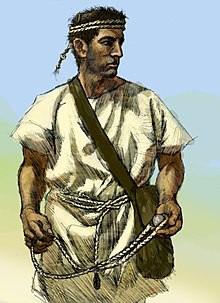
Combat
It is clear that many ancient peoples used the sling in combat and that organised armies included specialist slingers as well as equipping regular soldiers with slings as a backup weapon. As a weapon, the sling had several clear advantages. In general, a sling bullet lobbed in a high trajectory can achieve ranges approaching 400 m;[11] the current Guinness World Record distance of an object thrown with a sling stands at 477.0 m, set by David Engvall in 1992 using a metal dart. Larry Bray held the previous world record (1982), in which a 52 g stone was thrown 437.1 m. Modern authorities vary widely in their estimates of the effective range of ancient weapons and of course bows and arrows could also have been used to produce a long-range arcing trajectory, but ancient writers repeatedly stress the sling's advantage of range. The sling was light to carry and cheap to produce; ammunition in the form of stones was readily available and often to be found near the site of battle. The ranges the sling could generate with molded lead glandes was only topped by the heavy English longbows (with draw weights exceeding 150+ pounds) centuries later, and then at massively greater cost.
Caches of sling ammunition are frequently found at the sites of Iron Age hill forts of Europe. 40,000 sling stones were found at Maiden Castle, Dorset. It is proposed that Iron Age hill forts of Europe were designed to maximise the effectiveness of defending slingers.
The hilltop location of the wooden forts would have given the defending slingers the advantage of range over the attackers and multiple concentric ramparts, each higher than the other, would allow a large number of men to create a hailstorm of stone. Consistent with this, it has been noted that, generally, where the natural slope is steep, the defences are narrow and where the slope is less steep, the defences are wider.
Construction
A classic sling is braided from non-elastic material. The classic materials are flax, hemp or wool; those of the Balearic islanders were said to be made from a type of rush. Flax and hemp resist rotting, but wool is softer and more comfortable.
Braided cords are used in preference to twisted rope because a braid resists twisting when stretched. This improves accuracy.
The overall length of a sling could vary significantly and a slinger may have slings of different lengths, the longer sling being used when greater range is required. A length of about 61 to 100 cm (2.00 to 3.28 ft) would be typical.
At the centre of the sling, a cradle or pouch is constructed. This may be formed by making a wide braid from the same material as the cords or by inserting a piece of a different material such as leather. The cradle is typically diamond shaped and, in use, will fold around the projectile. Some cradles have a hole or slit that allows the material to wrap around the projectile slightly thereby holding it more securely; some cradles take the form of a net.
At the end of one cord, a finger-loop is formed. This cord is called the retention cord. At the end of the other cord it is common practice to form a knot. This cord is called the release cord. The release cord will be held between finger and thumb to be released at just the right moment. The release cord may have a complex braid to add bulk to the end. This makes the knot easier to hold and the extra weight allows the loose end of a discharged sling to be recovered with a flick of the wrist.
Polyester is an excellent material for modern slings, because it does not rot or stretch and is soft and free of splinters.
Modern slings are begun by plaiting the cord for the finger loop in the center of a double-length set of cords. The cords are then folded to form the finger-loop. The cords are plaited as a single cord to the pocket. The pocket is then plaited, most simply as another pair of cords, or with flat braids or a woven net. The remainder of the sling is plaited as a single cord, and then finished with a knot. Braided construction resists stretching, and therefore produces an accurate sling.
Ammunition
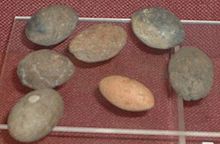

The simplest projectile was a stone, preferably well-rounded. Suitable ammunition is frequently from a river. The size of the projectiles can vary dramatically, from pebbles weighing no more than 50 g (2 oz) to fist-sized stones weighing 500 g (1 lb) or more.
Projectiles could also be purpose-made from clay; this allowed a very high consistency of size and shape to aid range and accuracy. Many examples have been found in the archaeological record.
The best ammunition was cast from lead. Leaden sling-bullets were widely used in the Greek and Roman world. For a given mass, lead, being very dense, offers the minimum size and therefore minimum air resistance. In addition, leaden sling-bullets are small and difficult to see in flight.
In some cases, the lead would be cast in a simple open mould made by pushing a finger or thumb into sand and pouring molten metal into the hole. However, sling-bullets were more frequently cast in two part moulds. Such sling-bullets come in a number of shapes including an ellipsoidal form closely resembling an acorn - this could be the origin of the Latin word for a leaden sling-bullet: glandes plumbeae (literally leaden acorns) or simply glandes (meaning acorns, singular glans).
Other shapes include spherical and, by far the most common, the biconical, which resembles the shape of the shell of an almond nut or a flattened American football.
The ancients do not seem to have taken advantage of the manufacturing process to produce consistent results; leaden sling-bullets vary significantly. The reason why the almond shape was favoured is not clear: it is possible that there is some aerodynamic advantage, but it seems equally likely that there is some more prosaic reason such as the shape being easy to extract from a mould or that it will rest in a sling cradle with little danger of rolling out.
Almond shaped leaden sling-bullets were typically about 35 mm (1 3/8 in) long and about 20 mm (3/4 in) wide weighing approximately 28 g (0.99 oz). Very often, symbols or writings were moulded into lead sling-bullets. Many examples have been found including a collection of about 80 sling-bullets from the siege of Perusia in Etruria from 41 BC, to be found in the museum of modern Perugia. Examples of symbols include a stylised lightning bolt, a snake, and a scorpion - reminders of how a sling might strike without warning. Writing might include the name of the owning military unit or commander or might be more imaginative: "Take this," "Ouch," and even "For Pompey's backside" added insult to injury, whereas dexa (catch!) is just sarcastic.
Julius Caesar writes about clay shot being heated before slinging, so that it might set light to thatch.
The sling in medieval period
Europe
By the Middle Ages the shepherd's sling was largely militarily extinct outside the Iberian peninsula, where the Spanish and Portuguese infantry favoured it against light and agile Moorish troops; a sling projectile, while dangerous even against an armoured opponent, would be lethal against a light and unarmoured foe. The staff sling (see below) continued to be used in sieges and the sling was used as a part of large siege engines.
The sling continued in use for the hunting of game.
The Americas

The sling was known throughout the Americas.[12]
In the ancient Andean civilizations such as Inca Empire slings were made from llama wool. These slings typically have a cradle that is long and thin and features a relatively long slit. Andean slings were constructed from contrasting colours of wool; complex braids and fine workmanship result in beautiful patterns. Ceremonial slings were also made; these were large, non-functional and generally lacked a slit. To this day, ceremonial slings are used in parts of the Andes as accessories in dances and in mock battles. They are also used by llama herders; the animals will move away from the thump of a stone. The stones are not slung to hit the animals, but to persuade them to move in the desired direction.
The sling was used for hunting and warfare. One notable use was in Incan resistance against the conquistadors. These slings were apparently very powerful; in 1491: New Revelations of the Americas Before Columbus, historian Charles C. Mann quoted a conquistador, who said that an Incan sling "could break a sword in two pieces" and "kill a horse."[13] Some slings could hurl massive stones and its span could be as much as 86 inches (2.18 m) and could weigh an impressive 14.4 ounces (408g).[14][15]
Variants

Staff sling
The staff sling, also known as the stave sling, fustibalus (Latin), fustibale (French), consists of a staff (a length of wood) with a short sling at one end. One cord of the sling is firmly attached to the stave and the other end has a loop that can slide off and release the projectile. Staff slings are extremely powerful because the stave can be made as long as two meters, creating a powerful lever. Ancient art shows slingers holding staff slings by one end, with the pocket behind them, and using both hands to throw the staves forward over their heads.
The staff sling has a similar range to the shepherd's sling, and can be as accurate in practiced hands. It is generally suited for heavier missiles and siege situations as staff slings can achieve very steep trajectories for slinging over obstacles such as castle walls. The staff itself can become a close combat weapon in a melee. The staff sling can throw heavy projectiles a much greater distance and at a higher arc than a hand sling. Staff slings were in use well into the Age of Gunpowder, as grenade launchers; and were used in ship-to-ship combat to throw incendiaries as well.
The mechanism of action of the staff sling is the same as that of the launching arm of several pre-gunpowder siege engines, such as the trebuchet. A trebuchet is essentially a large staff sling powered by a falling weight, rather than by direct muscle power.
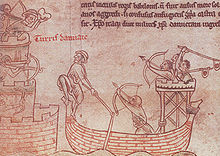
Kestros
The kestros (also known as the kestrosphendone, cestrus or cestrosphendone) is an intriguing sling weapon mentioned by Livy and Polybius. It seems to have been a heavy dart flung from a leather sling. It was invented in 168 BC and was employed by some of the Macedonian troops of King Perseus in Third Macedonian war.
Catapults
The trebuchet was a siege engine which uses the power of men pulling on ropes or the energy stored in a raised weight to rotate what was, again, a staff sling. It was designed so that, when the throwing arm of the trebuchet had swung forward sufficiently, one end of the sling would automatically become detached and release the projectile. Some trebuchets were small and operated by a very small crew; however, unlike the onager, it was possible to build the trebuchet on a gigantic scale: such giants could hurl enormous rocks at huge ranges. Trebuchets are, in essence, mechanised slings.
Slings today

Classic traditional woolen slings are still in use in the Middle East by Arab nomads and Beduines to ward off jackals and hyenas. They were also used during the various Palestinian Intifadas against modern army personnel and riot police. The sling is used today as a weapon primarily by protestors, launching either stones or incendiary devices, such as Molotov cocktails. International Brigades used slings to throw grenades during the Spanish Civil War. Similarly, the Finns made use of sling-launched Molotov cocktails in the Winter War against Soviet tanks. Slings have been used in the 2008 disturbances in Kenya.[16][17]
The sling is of interest to athletes interested in, for example, breaking distance records. Traditional slinging is still practiced as it always has been in the Balearic Islands. And competitions and leagues are common. In the rest of the world the sling is primarily a hobby weapon and a growing number of people make and practice with them. In recent years 'slingfests' have been held in Wyoming, USA, in September 2007 and in Staffordshire, England, in June 2008.
According to the Guinness Book of World Records, the current record for the greatest distance achieved in hurling an object from a sling is: 477.10 m (1,565 ft 3 in), using a 127 cm (50 in) long sling and a 62 g (2.2 oz) dart. This was achieved by David Engvall at Baldwin Lake, California, USA on 13 September 1992. Those of a more traditional bent may prefer the Guinness record for slinging a stone: 437.10 m (1,434 ft 1 in), using a 129.5 cm (51.0 in) long sling and a 52 g (1.8 oz) ovoid stone, set by Larry Bray in Loa, Utah, USA on 21 August 1981.
The principles of the sling may find use on a larger scale in the future; proposals exist for tether propulsion of spacecraft, which functionally is an oversized sling to propel a spaceship.

Sling methods
A skillful throw requires just one rapid rotation. Some slingers will rotate the sling slowly once or twice to seat the projectile in the cradle.
One makes an overhand throw, using the sling to extend one's arm. The motion is similar to bowling a cricket ball. This is relatively accurate, instinctive and quite powerful. One faces 60 degrees away from the target, with one's weak hand closest to the target. The coordinated motion is to move every part of the body, legs, waist, shoulders, arms, elbows and wrist in the direction of the target in order to add as much speed as possible to the stone. One releases the projectile near the top of the swing, where the projectile will proceed roughly parallel to the surface of the earth.
Another method of release said to be favoured by slingers firing into grouped or massed targets is an underhand throw. The motion is similar to that of throwing a softball. The trajectory arc is relatively high. The thrower stands 60 degrees away from the target, and takes one step forward from the trailing foot, letting the sling swing forward. Range is said to be increased with this method, sacrificing accuracy. Several historians have conjectured that this was the most commonly used method in ancient warfare due to its practicality.
There are also sideways releases, in which the swing goes around. These throws make it very easy to miss the target by releasing the projectile at a slightly wrong time. Other slinging methods can be seen, but many authorities deprecate them.
The clumsiest part of using a shepherd's sling is to regain control of the release cord. Conventionally, the loop of the retention cord is placed around a finger of the strong hand. Several projectiles may be held in the weak hand. After the release, an expert will continue the motion. The cradle will catch around a stone held out with the weak hand, so that the end of the release cord swings back to the strong hand retaining the loop. Just after the knot begins to swing, slightly before the knot reaches the strong hand, one drops or throws the projectile toward the ground with the weak hand, starting into the next release. Some people braid the end of the release cord around a weight to help perform this maneuver. With this method, a skillful user can throw an aimed stone every few seconds in a cyclic coordinated movement, until the weak hand is empty.
See also
Footnotes
- ^ Image of sling from the Tomb of Tutankhamen.
- ^ Image of the Lahun sling and reconstruction by Burgess.
- ^ William Smith, LLD. William Wayte. G. E. Marindin (1890). "Image "Soldier with sling. (From the Column of Trajan)"". A Dictionary of Greek and Roman Antiquities. London: John Murray.
{{cite book}}: External link in|chapterurl=|chapterurl=ignored (|chapter-url=suggested) (help) - ^ "The Iliad of Homer, translated by Cowper". Gutenberg.org. 2005-08-05. Retrieved 2010-09-12.
- ^ "Xenophon, Anabasis, chapter III". Gutenberg.org. 1998-01-01. Retrieved 2010-09-12.
- ^ Lucretius, On the Nature of Things-- "Just as thou seest how motion will o'erheat / And set ablaze all objects, - verily / A leaden ball, hurtling through length of space, / Even melts."
- ^ Virgil, The Aeneid, Book 9, Stanza LXXV – "His lance laid by, thrice whirling round his head / The whistling thong, Mezentius took his aim. / Clean through his temples hissed the molten lead, / And prostrate in the dust, the gallant youth lay dead."
- ^ "LacusCurtius • Strabo's Geography — Book III Chapter 5". Penelope.uchicago.edu. Retrieved 2010-09-12.
- ^ "Digital | Attic - Warfare: De Re Militari Book I: The Selection and Training of New Levies". Pvv.ntnu.no. Retrieved 2010-09-12.
- ^ Yigael Yadin, The Art of Warfare in Biblical Lands (Jerusalem: International Publishing Company, 1963), 34-35
- ^ Harrison, Chris (2006). "The Sling in Medieval Europe". The Bulletin of Primitive Technology. 31.
{{cite journal}}: Unknown parameter|month=ignored (help) - ^ Paul Campbell. "The Chumash Sling". ABOtech.com. Retrieved 16 May 2007.
- ^ Mann, pg. 84.
- ^ "Slings from Peru and Bolivia". Flight-toys.com. 2010-02-18. Retrieved 2010-09-12.
- ^ Jane Penrose. Slings in the Iron Age. Retrieved 30 June 2010.
- ^ "Ethnic Clashes in Kenya". New York Times. 2008-02-03.
- ^ Jeffrey Gettleman (2008-02-01). "Second Lawmaker Is Killed as Kenya's Riots Intensify". New York Times.
Further reading
- Burgess, E. Martin (1958). "An Ancient Egyptian Sling Reconstructed". Journal of the Arms and Armour Society. 2 (10): 226–30.
{{cite journal}}: Unknown parameter|month=ignored (help) - Dohrenwend, Robert (2002). "The Sling. Forgotten Firepower of Antiquity" (PDF). Journal of Asian Martial Arts. 11 (2): 28–49.
- Richardson, Thom, "The Ballistics of the Sling", Royal Armouries Yearbook, Vol. 3 (1998)
External links
- Slinging.org resources for slinging enthusiasts.
- Sling Weapons The Evolution of Sling Weapons
- The Sling - Ancient Weapon
- Sports and Pastimes of the People of England, Joseph Strutt, 1903.
- Funda, William Smith, A Dictionary of Greek and Roman Antiquities.
